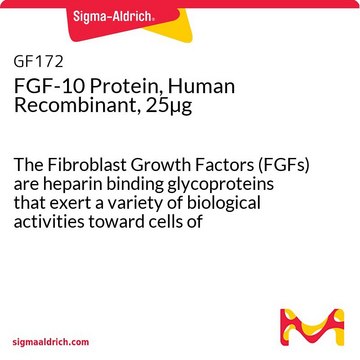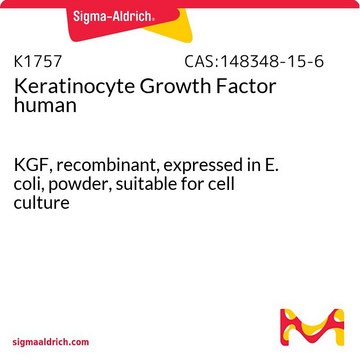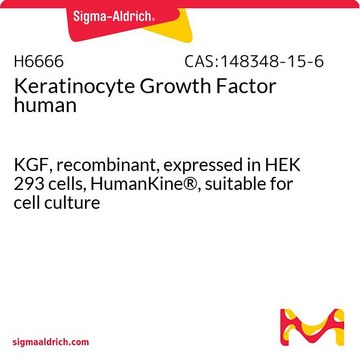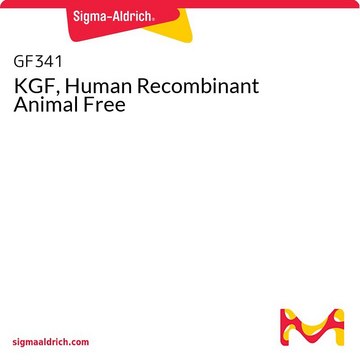SRP6161
FGF-7 human
recombinant, expressed in human cells, ≥95% (SDS-PAGE)
Synonym(s):
Fibroblast growth factor 7, HBGF-7, Heparin-binding growth factor 7, KGF, Keratinocyte growth factor
Sign Into View Organizational & Contract Pricing
Select a Size
All Photos(1)
Select a Size
Change View
About This Item
UNSPSC Code:
12352202
NACRES:
NA.32
Recommended Products
General description
Fibroblast growth factor-7 (FGF-7) is a member of the fibroblast growth factor family. FGF family members possess broad mitogenic and cell survival activities. The gene encoding this protein is localized on human chromosome 15q21.1.
Biochem/physiol Actions
Fibroblast growth factor (FGF) family members are involved in a variety of biological processes, including embryonic development, cell growth, morphogenesis, tissue repair, tumor growth and invasion. FGF7 is a potent epithelial cell-specific growth factor, whose mitogenic activity is predominantly exhibited in keratinocytes but not in fibroblasts and endothelial cells. This protein associates with and activates fibroblast growth factor receptors (FGFRs). Studies of mouse and rat homologs of this gene implicated roles in morphogenesis of epithelium, re-epithelialization of wounds, hair development and early lung organogenesis.
Physical form
Lyophilized from a PBS solution.
Preparation Note
Centrifuge the vial prior to opening.
Reconstitution
Reconstitute in sterile PBS containing 0.1% endotoxin-free, recombinant human serum albumin.
Storage Class
11 - Combustible Solids
wgk_germany
WGK 3
flash_point_f
Not applicable
flash_point_c
Not applicable
Choose from one of the most recent versions:
Certificates of Analysis (COA)
Lot/Batch Number
Don't see the Right Version?
If you require a particular version, you can look up a specific certificate by the Lot or Batch number.
Already Own This Product?
Find documentation for the products that you have recently purchased in the Document Library.
Xiao-Jing Zhu et al.
PLoS genetics, 10(10), e1004687-e1004687 (2014-10-21)
Epidermal stratification of the mammalian skin requires proliferative basal progenitors to generate intermediate cells that separate from the basal layer and are replaced by post-mitotic cells. Although Wnt signaling has been implicated in this developmental process, the mechanism underlying Wnt-mediated
Krijn K Dijkstra et al.
Cell, 174(6), 1586-1598 (2018-08-14)
Cancer immunotherapies have shown substantial clinical activity for a subset of patients with epithelial cancers. Still, technological platforms to study cancer T-cell interactions for individual patients and understand determinants of responsiveness are presently lacking. Here, we establish and validate a
The Fibroblast Growth Factor signaling pathway.
Ornitz DM and Itoh N
Wiley Interdisciplinary Reviews. Systems Biology and Medicine, 4(3), 215-266 (2015)
A family-based association study after genome-wide linkage analysis identified two genetic loci for renal function in a Mongolian population.
Park H
Kidney International, 83(2), 285-292 (2013)
Laxmi Yeruva et al.
mBio, 5(3), e01241-e01214 (2014-06-26)
It is not currently possible to predict the probability of whether a woman with a chlamydial genital infection will develop pelvic inflammatory disease (PID). To determine if specific biomarkers may be associated with distinct chlamydial pathotypes, we utilized two Chlamydia
Our team of scientists has experience in all areas of research including Life Science, Material Science, Chemical Synthesis, Chromatography, Analytical and many others.
Contact Technical Service








